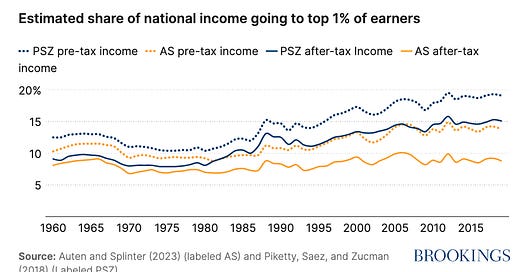Is America Today Really No More Unequal Economic Class-Wise than It Was in 1960?
America is much more unequal, class-wise! (Race-wise & gender-wise it is less unequal; but other-sociological-wise—i.e., life-expectancy—it looks much more unequal; summing the sociology factors is
America is much more unequal, class-wise! (Race-wise & gender-wise it is less unequal; but other-sociological-wise—i.e., life-expectancy—it looks much more unequal; summing the sociology factors is beyond my competence…
As I understand things, Thomas Piketty, Emmanuel Saez, and Gabriel Zucman (PSZ) have corrected some errors they made in calculating the top 1% after-tax-and-transfer income share that were pointed out by Gerald Auten and David Splinter (and others).
PSZ now think the top 1% post-fisc share has risen from 9%→15% over 1960→2019.
But Auten and Splinter are not satisfied, and claim the post-tax-and-transfer income share rose only from 8%→9%.
Now come Gale, Sabelhaus, and Thorpe (GST) to keep score. And I am here to score their score…
My conclusion: The numbers to keep in your head for the top 1% are: 9%→14.2%.
But—and all this is really important!—there is a bunch of uncertainty about levels and differences and about the difference between post-fisc income and what we would really like to measure that either substantially attenuates or substantially amplifies that rise in inequality. And I would bet on “amplifies”, but not with a great deal of confidence. And I would say that the sociology of inequality changes in America since 1960 is probably at least as important as the money flows, and that I get confused about it whenever I try to think about it.
Keep reading with a 7-day free trial
Subscribe to Brad DeLong's Grasping Reality to keep reading this post and get 7 days of free access to the full post archives.





